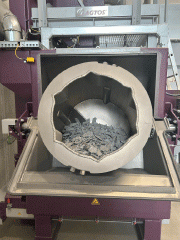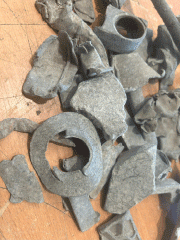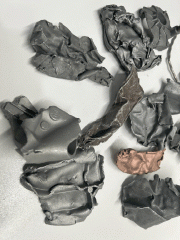E-Archive
Articles
in Vol. 26 - May Issue - Year 2025
Paint Stripping of Steel and Metal Substrates Before Recycling: Process, Efficiency, and Environmental Aspects

Recycled material in an AGTOS drum blast machine

Recycled material before the blasting process

Recycled material after the blasting process

Table: Comparison of Paint Stripping Processes at a Glance
The paint stripping of steel and other metal substrates is a critical step in the recycling process that significantly influences the quality of the recycled material and the efficiency of subsequent processing steps. Various processes are used, differing in efficiency, energy consumption, CO2 emissions, and hazardous waste generation.
Shot-Blast Machines
Shot-blast machines play a central role in mechanical paint stripping. These systems use covering caps to propel abrasive particles onto the metal surface at high speed. Due to their kinetic energy and geometric shape, these particles remove paint, rust, and other contaminants. Such machines are particularly widespread in the automotive and steel processing industries. In Germany, shot-blast machines are used in approximately 60–70% of large steel recycling plants. They are also widely used worldwide, particularly in industrialized countries with advanced recycling infrastructures such as the USA, Japan, and South Korea, where they are found in around 50–60% of all large recycling machines.
The use of shot-blast machines offers several advantages. They can clean large areas in a short time, making them particularly suitable for industrial applications. Additionally, shot-blast machines can be easily scaled and adapted to the required surface throughput by adjusting the number of turbines and their output. Unlike manual blasting, shot blasting processes are fully automated, reducing labor requirements and minimizing health risks. Compared to chemical processes, shot-blast machines produce less hazardous waste and have a lower environmental impact.
Another advantage is the flexibility shot-blast machines provide. The abrasive material can be adapted to the composition of the parts intended for reuse, preventing contamination during subsequent melting if blasting abrasives are carried in. As a result, the purity and quality of the materials remain unaffected, allowing for direct processing in subsequent steps.
However, operating these machines requires considerable amounts of energy, a factor that even operators sometimes overlook in their rough calculations of hourly machine rates.
Thermal Paint Stripping Process
Thermal processes utilize high temperatures to burn off paints and coatings. This method is often used for large-area and thickly coated metals. While thermal processes are highly effective and fast, they generate significant CO2 emissions and have the highest energy consumption of all paint stripping methods. As a result, this method is less commonly used in Germany and other countries with strict environmental regulations.
Chemical Paint Stripping Processes
Chemical paint stripping involves immersing metal parts in chemicals that dissolve the paint layers. This method is particularly effective for removing stubborn coatings and is gentle on sensitive parts, as it does not introduce mechanical stress on the material. In Germany, chemical processes are used in approximately 30% of recycling plants, particularly in industries with high-quality requirements such as aviation and electronics. Globally, chemical processes account for around 20–30% of recycling operations.
It should be noted that chemical processes entail significant environmental and health risks, requiring considerable effort and responsibility on the part of operators to ensure proper control. While these areas are comprehensively regulated by law in Central Europe, this is not the case everywhere. The responsible use of chemicals necessitates specialized disposal procedures for hazardous waste and trained personnel, leading to increased labor costs. Additionally, the carbon footprint must account for both the production and disposal of chemicals.
Energy Comparison and CO2 Emissions
A comparison of energy consumption among these processes shows that thermal paint stripping has the highest energy demand, followed by wheel blasting systems, with chemical processes consuming the least. Thermal processes also perform the worst in terms of CO2 emissions, while wheel blast cleaning systems and chemical processes perform better in relative terms, despite their specific challenges.
Application Perspectives and Opportunities for Improvement
The increased use of wheel blasting systems offers numerous advantages and can significantly improve the efficiency and environmental sustainability of recycling. Efficiency can be further enhanced by implementing state-of-the-art control technology and optimized covering caps. Additionally, CO2 emissions can be further reduced through the use of green energy and more energy-efficient drives. Integrating these systems into existing automation frameworks helps to further reduce labor costs and increase overall production efficiency, thereby mitigating the skilled labor shortage.
The recycling or thermal utilization of blasted paint material could present an interesting and promising opportunity.
Conclusion
In summary, shot-blast machines provide an efficient, environmentally friendly, and cost-effective solution for paint stripping steel prior to recycling. They offer numerous advantages over chemical and thermal processes. The targeted use and optimization of such systems make a significant contribution to improving the quality of recycled material while minimizing the environmental impact of the process.
Ulf Kapitza
Head of Business Development & Marketing of AGTOS
For Information:
Sinto AGTOS GmbH Gutenbergstr. 14 48282 Emsdetten, Germany
Tel. +49.2572.96026-0
E-mail: marketing@agtos.de




























